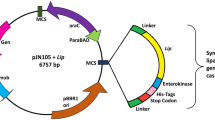Abstract
The lux biosensor of E. coli MG1655 (pDinI::lux) was constructed and a comparative study of the SOS response of three biosensors E. coli MG1655 (pRecA::lux), E. coli MG1655 (pColD::lux), and E. coli MG1655 (pDinI::lux) under the action of genotoxic agents was performed. The listed biosensors were named, respectively, PRecA, PColD, and PDinI. The response amplitude (RA) was chosen as an indicator of the SOS response level of lux biosensors. It was shown that RA of the PDinI biosensor was more expressed than RA of the PRecA biosensor under the action of hydrogen peroxide, alkylating agents such as NMU, MMS, and streptozotocin, antibacterial agent such as dioxidine, and cytostatics such as mitomycin C and cisplatin. Antimetabolite 5-fluorouracil showed activity only with PDinI. Furacilin and 4-NQO, whose metabolites form adducts with DNA, were more active on PColD than on PRecA and PDinI. DNA gyrase inhibitors such as nalidixic acid and ciprofloxacin were less active on PDinI than on PColD and PRecA. Overall, among 13 tested substances, 8 more actively induced SOS response in the PDinI biosensor than in PColD and PRecA. At the same time, 5-fluororacil induced SOS response only with the PDinI biosensor. It was concluded that the PDinI biosensor can be successfully used for the primary detection of potential genotoxicants by their ability to induce SOS response in E. coli cells.



Similar content being viewed by others
REFERENCES
Vollmer, A.C., Belkin, S., Smulski, D.R., et al., Detection of DNA damage by use of Escherichia coli carrying recA'::lux, uvrA'::lux, or alkA'::lux reporter plasmids, Appl. Environ. Microbiol., 1997, vol. 63, pp. 2566—2571.
Davidov, Y., Rozen, R., Smulski, D.R., et al., Improved bacterial SOS promoter&Colon: lux fusions for genotoxicity detection, Mut. Res., 2000, vol. 466, pp. 97—107.
Norman, A.A., Hansen, L.H., and Sørensen, S.J., Construction of a ColD cda promoter-based SOS-green fluorescent protein whole-cell biosensor with higher sensitivity toward genotoxic compounds than constructs based on recA, umuDC, or sulA promoters, Appl. Environ. Microbiol., 2005, vol. 71, pp. 2338—2346. https://doi.org/10.1128/AEM.71.5.2338-2346.2005
Manukhov, I.V., Kotova, V.Yu., and Zavilgelsky, G.B., Action of 1,1-dimethylhydrazine on bacterial cells is determined by hydrogen peroxide, Mut. Res., 2007, vol. 634, pp. 176—179.
Song, Y., Li, G., Thornton, S.F., and Thompson, I.P., Optimization of bacterial whole cell bioreporters for toxicity assay of environmental samples, Environ. Sci. Technol., 2009, vol. 43, no. 20, pp. 7931—7938.
Kotova, V.Yu., Manukhov, I.V., and Zavilgelsky, G.B., Lux biosensors for detecting SOS response, heat shock and oxidative stress, Biotekhnologiya, 2009, no. 6, pp. 16—25. https://doi.org/10.1134/S0003683810080089
Zavilgelsky, G.B., Kotova, V.Yu., and Manukhov, I.V., Sensor bioluminescent systems based on lux operons for the toxic substances detection, Khim. Fiz., 2012, vol. 31, no. 10, pp. 15—20.
Ahn, J.-M., Hwang, E.T., Youn, C.-H., et al., Prediction and classification of the modes of genotoxic actions using bacterial biosensors specific for DNA damages, Biosens. Bioelectron., 2009, vol. 25, pp. 767—772. https://doi.org/10.1016/j.bios.2009.08.025
Igonina, E.V., Marsova, M.V., and Abilev, S.K., Lux-biosensors: screening biologically active compounds for genotoxicity, Ekol. Genet., 2016, vol. 14, no. 4, pp. 52—62. https://doi.org/10.17816/ecogen14452-62
Van Dyk, T.K. and Rosson, R.A., Photorhabdus luminescens luxCDABE promoter probe vectors, Methods Mol. Biol., 1998, vol. 102, pp. 85—95.
Weng, M.-W., Zheng, Y., Jasti, V.P., et al., Repair of mitomycin C mono- and interstrand cross-linked DNA adducts by UvrABC: a new model, Nucleic Acids Res., 2010, vol. 38, no. 20, pp. 6976—6984.
Abilev, S.K. and Glaser, V.M., Genetic toxicology: findings and challenges, Russ. J. Genet., 2013, vol. 49, no. 1, pp. 70—80. https://doi.org/10.1134/S102279541301002X
McCann, J., Choi, E., Yamasaki, E., and Ames, B.N., Detection of carcinogens as mutagens in the Salmonella/microsome test: assay of 300 chemicals, Proc. Natl. Acad. Sci. U.S.A., 1975, vol. 72, pp. 5135—5139.
Quillardet, P., Huisman, O., D’Ari, R., et al., SOS chromotest, a direct assay of induction of an SOS function in Escherichia coli K12 to measure genotoxity, Proc. Natl. Acad. Sci. U.S.A., 1982, vol. 79, no. 19, pp. 5971—5975. https://doi.org/10.1073/pnas.79.19.5971
Quillardet, P. and Hofnung, M., SOS chromotest: a review, Mut. Res., 1993, vol. 297, pp. 235—279. https://doi.org/10.1016/0165-1110(93)90019-j
Cox, M.M., Regulation of bacterial RecA protein function, Crit. Rev. Biochem. Mol. Biol., 2007, vol. 42, no. 1, pp. 41—63. https://doi.org/10.1080/10409230701260258
Galkin, V.E., Britt, R.L., Bane, L.B., et al., Two modes of binding of DinI to RecA filament provide a new insight into the regulation of SOS response by DinI protein, J. Mol. Biol., 2011, vol. 408, pp. 815—824. https://doi.org/10.1016/j.jmb.2011.03.046
Voloshin, O.N., Ramirez, B.E., Bax, A., and Camerini-Otero, R.D., A model for the abrogation of the SOS response by an SOS protein: a negatively charged helix in DinI mimics DNA in its interaction with RecA, Genes Dev., 2001, vol. 15, pp. 415—427. https://doi.org/10.1101/gad.86290
Yasuda, T., Morimatsu, K., Kato, R., et al., Physical interactions between DinI and RecA nucleoprotein filament for the regulation of SOS mutagenesis, EMBO J., 2001, vol. 20, pp. 1192—1202. https://doi.org/10.1093/emboj/20.5.1192
Yasuda, T., Morimatsu, K., Horii, K., et al., Inhibition of Escherichia coli RecA coprotease by DinI, EMBO J., 1998, vol. 17, no. 11, pp. 3207—3216. https://doi.org/10.1093/emboj/17.11.3207
Longley, D.S., Harkin, D.P., and Johnston, P.G., 5‑Fluorouracil: mechanisms of action and clinical strategies, Nat. Rev. Cancer, 2003, vol. 3, no. 5, pp. 330—337. https://doi.org/10.1038/nrc1074
Funding
This study was financially supported by the Russian Foundation for Basic Research (project no. 190400200).
Author information
Authors and Affiliations
Corresponding author
Ethics declarations
The authors declare that they have no conflict of interest.
This study does not contain any research involving animals as research objects.
This study does not contain any research involving people as an object.
Rights and permissions
About this article
Cite this article
Abilev, S.K., Kotova, V.Y., Smirnova, S.V. et al. Specific Lux Biosensors of Escherichia coli Containing pRecA::lux, pColD::lux, and pDinI::lux Plasmids for Detection of Genotoxic Agents. Russ J Genet 56, 666–673 (2020). https://doi.org/10.1134/S1022795420060022
Received:
Revised:
Accepted:
Published:
Issue Date:
DOI: https://doi.org/10.1134/S1022795420060022




